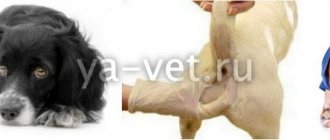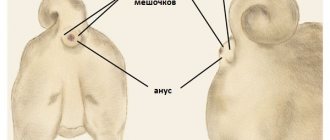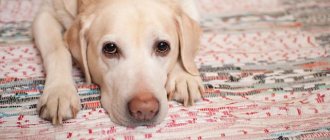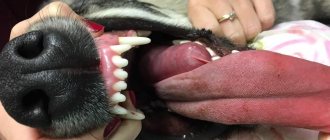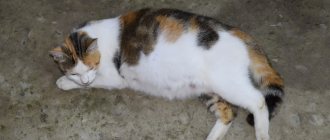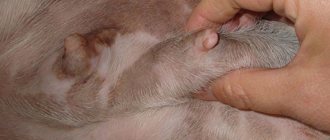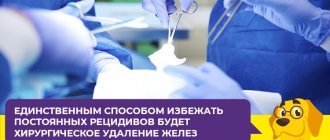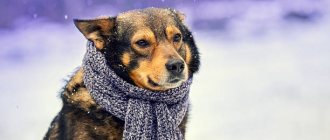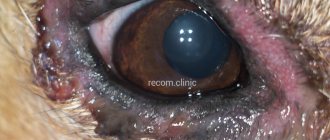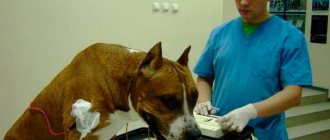What are paraanal glands and what function do they perform in dogs?
The anal glands (less commonly called sacs) are located in the area where the rectum meets the anus (anus). This is a paired organ. It secretes a specific secretion that has an individual scent for each dog.
It is thanks to this that pets can navigate and know exactly who was recently in a certain place. With the help of a secret, they mark their territory, can scare away enemies or attract other individuals.
Paraanal glands or anal sacs
This fluid is released during bowel movements and mixed with feces. But this does not happen in all dogs. The normal functioning of the paraanal glands depends on the activity of the intestines and digestive system. Feces squeeze out secretions from the sacs every time you have a bowel movement. If there are problems in the gastrointestinal tract, this naturally does not happen.
Treatment
The veterinarian will treat the root cause of the discharge together with the elimination of symptoms.
- In all cases, special nutrition is prescribed. For example, you should exclude dry food from your dog’s diet, as they are difficult to digest. Be sure to add foods high in fiber, which will improve digestion and intestinal motility.
- In case of helminthic infestation, deworming drugs are prescribed: tablets (Drontal Plus, Milbemax), sugar cubes (Polivercan), suspensions (Procox).
- If the tumors can be removed, then surgery is performed. If not, then radiotherapy or chemotherapy. Then the immune system is restored.
- Inflammation that has passed from the colon is eliminated with the help of anti-inflammatory drugs - rectal suppositories with ichthyol.
- The anal glands are opened, cleaned and disinfected. Antibacterial agents must be prescribed: ointment (Amoxicillin), intramuscular injections. Suppositories are placed in the anus (Proctosedyl, Ichthyol). In severe cases, the glands are removed.
Success in treatment depends on timely contact with a veterinary specialist.
Causes of inflammation
Inflammation of the paraanal glands in a dog does not develop on its own. The condition is always provoked by external or internal factors. This may be affected by:
- physical inactivity – if a dog leads a sedentary lifestyle, the likelihood of developing inflammation increases;
- heredity, that is, a predisposition to a pathological condition;
- slow metabolism and reduced immunity;
- pregnancy or period of feeding puppies;
- erratic or very frequent matings;
- various injuries that aggravate the life of the pet.
Inflammation of the anal glands in a dog can develop due to improper bowel movements. Most often, this is affected by poor and unhealthy nutrition. For example, if your pet eats a large amount of bones or low-quality processed foods.
Another reason may be failure to comply with basic animal hygiene standards. If the owner does not wash it on time and does not ensure that the pet is clean, the likelihood of developing a pathological condition increases.
At-risk groups
Inflammatory processes in the paraanal glands are most often identified in certain breeds of dogs. Usually these are dwarf and decorative pets. For example:
- bulldogs - English and French;
- Pekingese;
- dachshunds;
- Pugs.
This also applies to other small breeds, which most often develop gastrointestinal problems. In addition, their sacs are inconveniently located, which prevents them from being completely emptied and leads to them becoming clogged with secretions.
How to Determine When It's Time for Your Pet to Have Anal Glands Cleaned
If the secretion accumulates in the gland for a long time, then the animal begins to experience discomfort in a certain area. The dog tries to squeeze out the contents of the bags on its own. At such moments, the pet begins to behave as its natural instincts tell it.
If the anal glands in dogs are clogged, the animal begins to behave as follows:
- Rubs her butt on the floor, especially on its fleecy surfaces. In such cases, many pet owners begin to think that their pet has worms. But they could be wrong.
- If friction on the floor fails to squeeze out the secretion, the dog tries to chew under its tail. The animal may suddenly jump up, twist towards its tail, trying to catch an invisible enemy. Sometimes it comes to the point that the animal chews out the fur under its tail.
- An unpleasant, previously unusual odor appears from the anus.
If you notice all these symptoms in your pet, then most likely he needs cleaning of the anal glands. If you are a squeamish person, or are afraid of harming your pet, then, of course, it is better to go to a veterinary clinic.
But in fact, if there is no inflammation in the anal area, and if the dog does not experience pain when pressed, then you can clean your pet’s anal glands yourself. Cleaning the glands, although not the most pleasant procedure, is quite simple.
Signs and symptoms of the disease
The clinical picture depends on the severity of the inflammatory process. Separately, it is worth noting other symptoms in dogs that appear less frequently, but also deserve attention.
The first degree of inflammation of the paraanal glands is characterized by severe itching. That's why dogs scratch the anus area. The secretion is released in small quantities. Its color can vary from whitish and watery to light, transparent or yellowish.
| Degree | Symptoms |
| Second | The amount of secretion decreases and becomes much thicker. The clinical picture is complemented by hair loss (alopecia), a rash on the skin of the inner thigh. The dog begins to feel stiff. It manifests itself in the girdle of the lower extremities. |
| Third | The secretion becomes very thick and acquires a creamy consistency. Its amount decreases, and the liquid itself becomes much darker. A sharp and unpleasant odor appears. The pet develops a neurological syndrome. Obsessive itching, pain and other unpleasant sensations appear. The dog becomes restless. |
| Fourth | The secretory fluid takes on the consistency of clay. It becomes grainy and thick. Color can vary from dark brown to black. |
In the most severe cases, paralysis develops. It affects the pelvic girdle or lower half of the body - near the hind legs. This indicates that the glands are completely clogged and blocking the nerves.
Additional symptoms
Your pet's behavior can change dramatically. The dog becomes much more aggressive and develops new habits. There may be a decrease in appetite or its complete absence.
There are pronounced pains. They are identified not only in the anus, but also at the base of the tail or between the anus and testicles. Other signs of inflammation of the paraanal glands in a dog:
- moisturizing the skin or coat;
- hyperkeratosis, namely excessive compaction of the epidermis;
- hypoesthesia - decreased or, less commonly, increased sensitivity;
- pain upon contact with the skin;
- obvious pigmentation;
- erythema, manifested as redness.
Rectocutaneous fistulas (perianal sinuses) may develop. As a result of the disease, various ulcerations and eroded areas are revealed.
There is a high probability of an increase in temperature and the development of a febrile state. Frequent scratching of the problem area causes the anus to visibly swell. Spasmodic pain appears. The dog may become depressed, fall into apathy and depression. Lethargy and chronic fatigue develop when the pet refuses feeding and walking.
Pet treatment methods
Inflammation of the paraanal glands can be treated in different ways. At the initial stage, they resort to periodic mechanical cleaning and a course of antibiotics. In the most difficult cases, surgical treatment is practiced. This will avoid the development of abscesses and other complications.
Mechanical cleaning and antibacterial treatment
It is carried out by the owner at home independently after consultation with a veterinarian. To do this, the pet is placed in a pre-prepared basin or bathtub.
Note! You must first prepare personal protective equipment. These are disposable sterile gloves and an antiseptic solution.
To facilitate the process, the animal must be restrained by a second assistant.
You need to take the dog by the base of the tail and lift it up. It is important that the pet does not feel pain or discomfort. In this case, he will calmly endure the procedure.
How to treat inflammation of the paraanal glands in dogs further:
- with the other hand, press symmetrically on the area where the anal glands are located, without making sudden or traumatic movements;
- wait until all the stagnant secretion flows out of the anus on its own;
- completely rinse off all acrid secretions with warm water to get rid of the pungent and unpleasant odor.
If such mechanical cleaning does not produce results, it is not recommended to carry it out again. The low effectiveness of the procedure may be associated with the pathology of the paraanal glands and their deeper location. In such a case, cleaning should be carried out by a veterinarian.
After mechanical cleaning, you need to use antibiotics. The drugs are prescribed as a whole course - for six to seven days. The most effective are Cephalexin and Amoxicillin. They are calculated based on the weight of the pet. Use from five to seven units per 1 kg of weight.
External cleaning
Sterile and clean wipes can be used to clean the anal glands. Rubber gloves will also be required. It is recommended to familiarize yourself with the technique of the procedure in advance by watching a video on the Internet or by looking at photos.
You can do external cleaning yourself. The pet is secured with one hand, and the procedure is carried out with the other.
The napkin is pressed tightly to the anus. Apply gentle pressure to compress the walls of the rectum. This is enough if the pouches are very clogged or are located in a standard manner, and not in the depths, as happens in some dog breeds.
External cleaning does not always achieve the desired result. The method may be ineffective if the secretion is thick enough and resembles dough in consistency.
Internal cleaning
It can also be carried out by the owner independently. To do this, use disposable gloves and insert two fingers into the anus.
The anal glands are squeezed out like a pimple. The main thing is to feel them and make movements on the sides. It will be most effective to start internal cleaning from afar. To do this, insert your fingers as deep as possible.
If the cleansing is successful, the secretion will be released immediately. To eliminate subsequent inflammation, it is recommended to use suppositories. Suppositories are used for two to three days. It can be longer if inflammation of the dog’s gland occurs more than once a year.
Surgical intervention
In some cases, even systematic cleansing of the problem area does not completely get rid of the secretion. Therefore, if the procedure has to be performed once a week or more often, veterinarians insist on surgery.
The doctor recommends saculectomy - complete removal of the paired organ. This will avoid possible relapses associated with an inflammatory reaction.
The operation is carried out according to the following algorithm:
- the surgeon makes two shallow incisions in the area of the glands;
- brings them out and excises them;
- sews up the skin.
The dog can defecate on its own within 18–24 hours. This is due to the fact that the rectum or anus is not affected during surgery.
The peculiarity of the dog’s gland is that it is not compact. The bags tend to grow in tissues, so relapses are possible after removal. This indicates that as part of the operation, the abscess (purulent cavity) and the paraanal gland were excised. However, not completely glandular tissue.
In order to ensure complete removal of glands that are inflamed, dyes are injected. It is in this case that the entire fabric will be truncated, because it will be 100% dyed.
The pet should not tolerate the urge to have a bowel movement while the wounds are healing. Otherwise, the seams may come apart. During the recovery stage after surgery, it is recommended to provide your pet with a diet and also walk it more often.
However, for quality postoperative care it is very important:
- every time after a walk, wash the area under the tail;
- treat the postoperative suture once a day;
- systematically use antibiotics for three to four days after the intervention.
The sutures are removed after two weeks. No special or expensive care for the animal after the operation is required in the future.
It is very important to choose a highly qualified specialist. This is due to the fact that the area of the anus and paraanal sacs is replete with a large number of nerve and vascular bundles. If the operation is performed incorrectly, it can lead to unpleasant consequences.
Cleaning the anal glands at home
To carry out the procedure at home, you need to purchase petroleum jelly and medical sterile gloves at the pharmacy. The most convenient place for cleaning is the bathroom, since the secretory fluid has a very unpleasant odor and can get on furniture. If it gets on the upholstery, it will not be easy to get rid of the stain, and in addition, the air in the room will be spoiled for a long time.
You should insert your index finger into the animal’s anus and feel the glandular formations on its sides, which are shaped like dense balls. Using light massage movements, you should empty the contents of the bags outward, the manipulation is carried out on both sides.
Treatment of inflammation in puppies
The rehabilitation course at home in this case has some features. For example, they refuse strong antibiotics unless absolutely necessary.
Mechanical cleaning is also risky. This is due to the fact that the anal glands and the tissues around them are very thin and delicate. It is acceptable to use rectal suppositories, but not completely. Before insertion, they are cut lengthwise into four parts. The resulting “straws” are inserted into the anus.
Important! The use of candles is completely discouraged. This can aggravate the condition of inflammation of the paraanal glands and even lead to complications.
The recommended treatment is surgical excision of the sacs. This is due to the fact that their pain threshold is slightly higher, as is the rate of tissue regeneration. Therefore, the easiest way would be to remove the glands so that they do not bother the dog in the future. After all, if inflammation appears at such a young age, then it will bother the puppy throughout his life.
Cleaning your dog's anal glands
An attentive owner will quickly determine how often gland blockage occurs. If this phenomenon is frequent, then cleaning is carried out once every 7-10 days.
The procedure is carried out using a damp cloth after bowel movement. Place a damp cloth on your hand and apply it to the sub-caudal area in the anus area. Pressing lightly, the fingers seem to slide from the sides to the center of the sphincter. The procedure is carried out with the tail raised as high as possible, not pulled to the side, but upward. This is how reflexive relaxation of the muscles occurs and manipulation is easy to carry out.
Genetic predisposition imposes a number of responsibilities. Cleaning the glands, as well as the ears, is a normal, regular event. There is no point in doing this in the bathroom using asepsis (gloves, shoe covers, etc.) this is a hygienic procedure. Even simply wiping the anal area with a napkin will be sufficient to prevent blockage of the excretory ducts.
If examination and sanitation is problematic for the animal owner, then you should visit the clinic. This should be done once every 2-3 months and immediately when any signs are detected. Perhaps the doctor conducting the examination and procedure will change the frequency and give his recommendations.
Possible complications
Inadequate treatment can have serious consequences. It is likely that an abscess or fistula will develop, the treatment of which will be difficult and painful for the dog.
An abscess is a swelling on the side of the anus. Please note that:
- it represents significant masses of pus in the sacs;
- the pet almost constantly experiences acute pain;
- this occurs both during bowel movements and at rest.
If the pus ducts become overgrown with connective tissue, a fistula is formed. This is a small or medium-sized hole in the dog's skin and other tissues. Pus constantly leaks out through it.
In such a situation, the pet feels very bad. He may lie and whine constantly. Body temperature increases. Together with other symptoms, this is very dangerous for the dog's health. There is a possibility of sepsis - an infectious blood infection. Therefore, it is necessary to contact a veterinarian as early as possible, bypassing the stage of complications.
Diet and feeding of a dog with inflammation of the paraanal glands
In this case, nutrition should be complete. It will help maintain your pet’s condition at the proper level and reduce the likelihood of complications.
The following conditions must be met in case of inflammation of the sebaceous glands in a dog:
- exclusion of any food from a person’s table;
- It is unacceptable to give your pet spicy, salty, smoked and fried foods;
- It is necessary to include more fiber in the diet to normalize intestinal motility and achieve maximum cleansing naturally.
In some cases, inflammatory changes are caused by excess weight. Then the veterinarian develops an individual diet. It will include only easily digestible foods. It is important that they are rich in vitamins, iron and minerals.
It is useful to eat boiled vegetables. For example, carrots, beets, zucchini. It is better to avoid potatoes and other starchy foods. It is advisable to introduce fermented milk products into the diet. Daily consumption of a small amount of kefir or natural cottage cheese will facilitate bowel movements.
When the gland under the tail is inflamed in dogs, it is advisable to give grains and bran in their pure form. This can be buckwheat and oatmeal, wheat or corn bran. This will also speed up the removal of waste products from the intestines.
Prevention
To eliminate the occurrence of such a problem, the dog’s health needs to be addressed immediately. This is especially important for those pets who are at risk.
It is necessary to increase physical activity. The dog should spend a lot of time outside and be active. This will stimulate intestinal peristalsis and provoke its wave-like contractions. Thanks to this, massage of the inflamed paraanal glands with feces will be more complete.
Not less important:
- Examine your pet. This will help identify possible chronic digestive diseases that may lead to gland blockage in dogs.
- Balance your diet. Eating too much protein in your diet will increase your likelihood of developing constipation. This will also lead to the development of inflammatory processes in the anal area.
- Cleanse the glands correctly and regularly. In this case, anti-inflammatory drugs must be used, and, if necessary, antibiotics. The owner must observe hygiene and personal protection measures.
Inflammation of the gland in dogs is an unpleasant but reversible condition. In order to cope with it, you can clean the bags yourself. It is recommended to walk the dog more often, improve nutrition, making it more nutritious. In the most difficult cases, veterinarians perform surgery to excise the glands. This is a radical but effective method of solving the problem.
